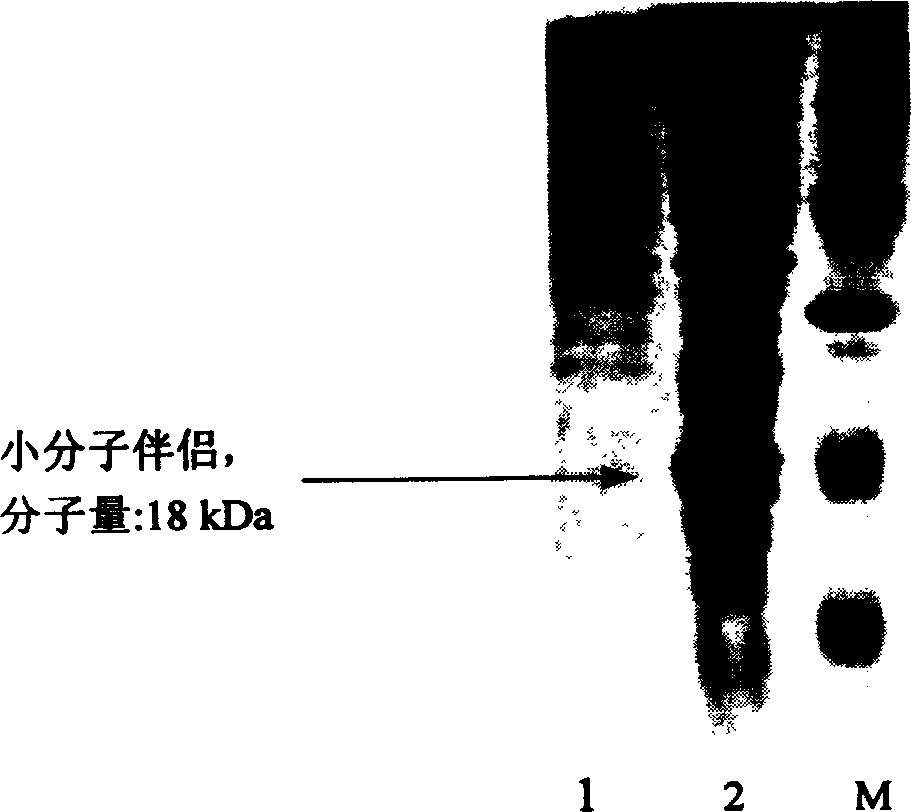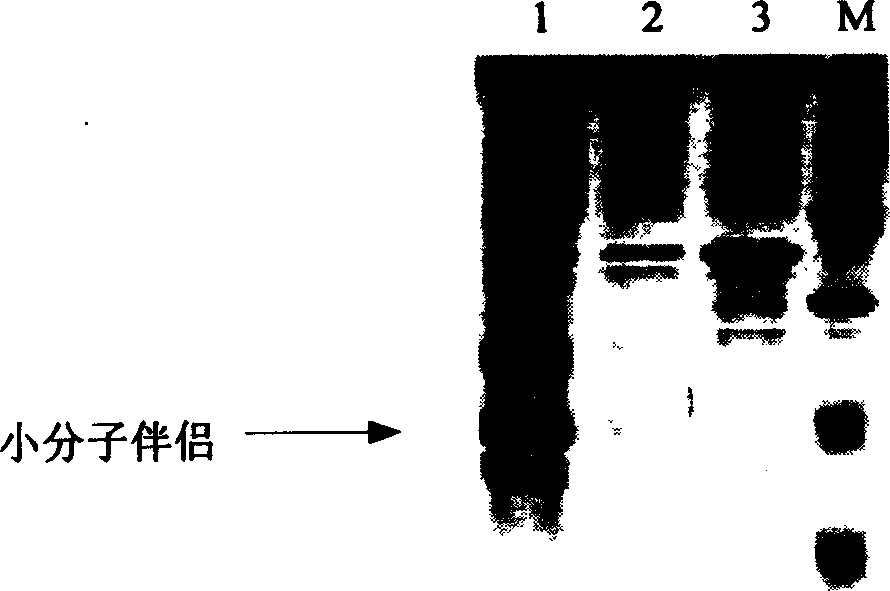Producing method for small molecule companion with gene engineering Escherichia coli
A technology of Escherichia coli and genetic engineering, which is applied in the field of genetic engineering Escherichia coli to produce new small molecular chaperones, can solve the problems of limiting GroEL protein renaturation research and industrial application, increasing the difficulty of plasmid construction and soluble expression, and large amount of GroEL, etc. The effect of mild conditions, high level of production automation and short production cycle
- Summary
- Abstract
- Description
- Claims
- Application Information
AI Technical Summary
Problems solved by technology
Method used
Image
Examples
Embodiment 1
[0054] The steps of the method for producing novel small molecule chaperones with genetically engineered Escherichia coli are as follows:
[0055] 1) Engineering bacteria fermentation
[0056] Pick a single bacterium colony from the solid medium and insert it into 50mL seed medium containing ampicillin, so that the bacterium concentration in the medium reaches 100mg / L, cultivate it in a 180rpm shaker at 33°C for 12 hours, and inoculum by 2% The previous culture solution was inserted into the seed medium containing ampicillin again, and cultivated for 10 hours at 33° C. in a shaker at 180 rpm, then the activated seed solution was added to the fermentation medium by 2% inoculum size, and ampicillin was added simultaneously to make The final concentration was 50 μg / mL, cultured in a shaker at 33°C and 180 rpm for 3 hours, then added placebo inducer isopropyl-β-D-thiogalactoside with a final concentration of 0.5 mM for induction, and continued to culture for 8 Hours, the new smal...
Embodiment 2
[0066] The steps of the method for producing novel small molecule chaperones with genetically engineered Escherichia coli are as follows:
[0067] 1) Engineering bacteria fermentation
[0068] Pick a single colony from the solid medium with a toothpick and insert it into 10mL of ampicillin-containing seed medium, so that the bacterial concentration in the medium reaches 100mg / L, culture in a shaker at 33°C and 180rpm for 16 hours, and inoculate at 1%. Add the previous culture solution to the seed medium containing ampicillin again, cultivate it in a shaker at 33°C and 180rpm for 12 hours, then add the activated seed solution to the fermentation medium according to the inoculum size of 1%, and add ampicillin at the same time Penicillin made the final concentration of 50μg / mL, cultured in a shaker at 33°C and 180rpm for 4 hours, then added placebo inducer isopropyl-β-D-thiogalactoside with a final concentration of 0.2mM for induction, continued After culturing for 7 hours, the ...
Embodiment 3
[0078] The steps of the method for producing novel small molecule chaperones with genetically engineered Escherichia coli are as follows:
[0079] 1) Engineering bacteria fermentation
[0080] Pick a single bacterium colony from the solid medium and insert it into 100mL seed medium containing ampicillin, so that the bacterium concentration in the medium reaches 200mg / L, cultivate it in a shaker at 250rpm at 37°C for 24 hours, and inoculum by 0.5% The previous culture solution was inserted into the seed culture medium containing ampicillin again, and cultivated in a shaker at 250 rpm for 12 hours at 37° C., then the activated seed solution was added to the fermentation medium by 0.5% inoculum size, and ampicillin was added simultaneously to make The concentration was 50 μg / mL, cultured in a shaker at 37°C and 250 rpm for 6 hours, then added the placebo inducer isopropyl-β-D-thiogalactoside with a final concentration of 1 mM for induction, and continued to culture for 9 hours. ...
PUM
 Login to View More
Login to View More Abstract
Description
Claims
Application Information
 Login to View More
Login to View More - Generate Ideas
- Intellectual Property
- Life Sciences
- Materials
- Tech Scout
- Unparalleled Data Quality
- Higher Quality Content
- 60% Fewer Hallucinations
Browse by: Latest US Patents, China's latest patents, Technical Efficacy Thesaurus, Application Domain, Technology Topic, Popular Technical Reports.
© 2025 PatSnap. All rights reserved.Legal|Privacy policy|Modern Slavery Act Transparency Statement|Sitemap|About US| Contact US: help@patsnap.com



